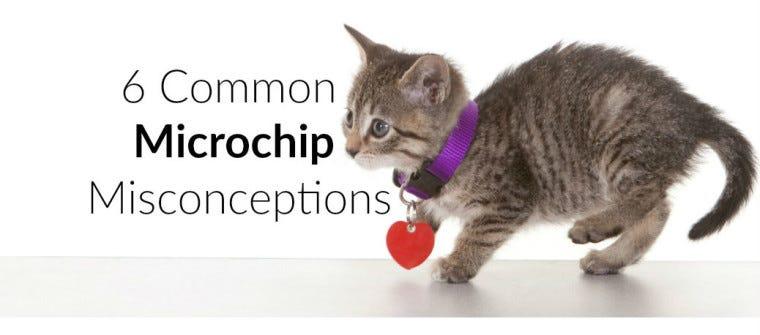June is National Microchipping Month. Whether your pet is already microchipped or you’re considering getting one, we’re here to clear up some common microchip misconceptions.
Microchipping may be the best option for you if you travel with your cat or dog, or if you leave them outside for extended periods of time. Read to learn the most common microchip misconceptions.
Misconception 1: My pet has an ID tag, so I don’t need a microchip.
All pets should wear collar tags imprinted with their name and your phone number, whether or not they also have a microchip.
Many cats don't wear collars or identification tags, or they become separated from their collar once lost. Only a microchip can provide permanent identification that cannot fall off, be removed, or become difficult to read.
We like to think it won't happen to us, but in the U.S., about 1 in 3 pets gets lost at some point in its life. Fewer than 2% of lost cats without microchips are returned home, according to one microchipping company. But if a cat is microchipped, the return-to-owner rate is 20 times higher than if the cat isn’t microchipped.
Misconception 2: A microchip is a tracking device.
A microchip is not a GPS tracking device; it cannot track your lost pet and tell you its location. Instead, microchipping is way to identify a pet's owner in the event it is lost.
The device is a small, electronic chip enclosed in a glass cylinder about the size of a grain of rice that is inserted under your pet's skin. It's a radio-frequency identification (RFID) implant that contains a unique identification number. The number is linked to your information and stored in an online database.
When a microchip scanner is passed over your pet's implant, the microchip uses power from the radio waves emitted by the scanner to transmit the identification number. Because RFID doesn't require a power source like a battery, you don't have to worry about keeping it charged or replacing it. It will last the lifetime of your pet!
Misconception 3: Microchipping requires surgery or anesthesia.
The microchipping procedure is simple and similar to administering a routine shot.
The microchip comes preloaded in a sterile applicator and is injected under the loose skin between the shoulder blades. The process takes only a few seconds. Your pet should not react any more than it would to a vaccination—no anesthetic required.
Only a qualified veterinarian should perform a microchip implantation. Many veterinary clinics keep microchips in stock, so it's likely that your pet can be implanted with a microchip the same day as your appointment.
Misconception 4: The shelter microchipped my pet, so we're protected.
Many people adopt pets that have already been microchipped by a rescue or shelter. New owners mistakenly believe that the microchip is linked to their name and information upon adoption. In fact, the chip is still linked to that organization's information.
Any time you adopt a pet that is microchipped, find out where it is registered and update the registration to link your new pet to your information. You may have to pay a small fee to update the information or learn that there is an annual fee you are now responsible to pay.
Misconception 5: If a pet is microchipped, any scanner can read it.
Competing microchip companies use different radio frequencies to send ID numbers to scanners. Until recently, there was no universal scanner that could read all frequencies. This was quite problematic if your pet was microchipped at a frequency the vet or shelter's scanner could not read. It would appear to them that there was no microchip at all.
Fortunately, it is increasingly true that if your pet is microchipped, vet offices, shelters, and rescues will have a scanner that can detect your pet's microchip. In fact, many microchip companies now make universal scanners and distribute them to shelters at little or no cost.
Misconception 6: Once your pet’s microchip is implanted, your work is done.
The biggest misconception about microchips is that once implanted, your pet is protected. But there's one more key step. Too often, lost animals are taken to shelters, scanned for microchips, and the ID number leads nowhere. Why? Because the microchip was never registered.
Register the microchip to connect its ID number to your information. Complete the registration through your particular microchip company or through any of the universal databases that allow registration of any brand's microchip. Some services charge a fee upon registration, annually, or each time you update information. No matter where you choose to register your pet's microchip, make sure you do it and keep the information up to date.
Ask your veterinarian to scan your pet's microchip at least once per year to make sure the microchip can be detected.
Recommendations








